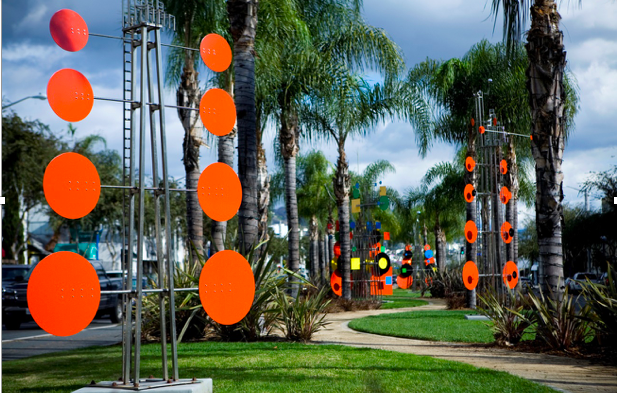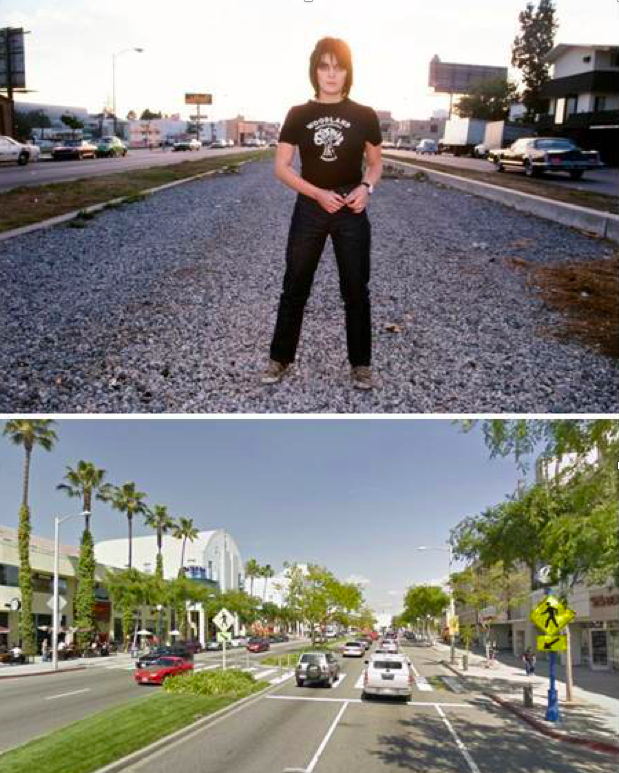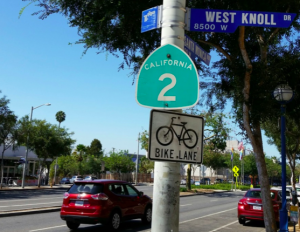
By 1997, West Hollywood officials were more than fed up with California’s Transportation Department (Caltrans). The state owned Santa Monica Boulevard – the city’s “main street” – but had done little to improve it since WeHo was incorporated 13 years earlier.
City leaders found Caltrans difficult to work with almost from the beginning, Joan English, transportation and public works director at the time, told the Los Angeles Times. “It’s our main street. Every time we want to do something such as have the crosswalks painted, we have to go to Caltrans, and they frequently say ‘no’.”
She also said Caltrans had done no major paving work since West Hollywood became a city in 1984, worsening a dilapidated thoroughfare with railroad tracks running along the middle that threatened basic operations and safety.
Local leaders knew they had to be bold and brave if the boulevard was going to accommodate basic amenities like sidewalk cafes, streetscape furniture and street trees. They also realized that they would have to be the ones to build an infrastructure to support a high-profile entertainment industry and tourist destination – and not stodgy state transportation planners.
WeHo forced Caltrans to the negotiating table in 1997 with the goal of wresting control of the street from the state.
“It became clear that relinquishment provided a unique opportunity to redesign Santa Monica Boulevard and reinforce its identity as West Hollywood’s main street. In the fall of 1998, the city reached an agreement with the state to reclaim the boulevard,” it said in a statement. A formal, final pact was inked in February 1999, records show.
The city took possession of the beat-to-hell-and-back roadway and got to work immediately planning a total reconstruction.
Occupying Santa Monica Boulevard
A completely rebuilt Santa Monica Boulevard was really something to cheer about in 2001 when work was finished. Two years of jackhammers and bulldozers produced a spanking new street, more and better sewer lines below, miles and miles of new sidewalks, dozens more parking spaces and 1,200 new trees.
The cost was nearly $1 million for each of the boulevard’s 38 blocks. The two-year, $34 million project upgraded all 38 blocks of the street. West Hollywood’s City Council deemed it party time and spent $153,000 on a street festival to celebrate, the Los Angeles Times reported. The reconstruction was the last nail in the coffin for Caltrans’ plan for the street.

Caltrans Dreamed of a Beverly Hills Freeway
State transportation planners long dreamed of a crosstown superhighway to connect the 405 Freeway on Los Angeles’ Westside with the 101 in Hollywood. All that remains today of their proposed but never built Beverly Hills Freeway are green and white “California 2” street signs that dot Santa Monica Boulevard through West Hollywood and beyond.
Those triangle-shaped signs, first erected in 1933, designated the boulevard as a state highway. The California Department of Transportation (Caltrans) took control because the street linked five cities or towns and provided vital access to beaches, UCLA and the retail, business and residential districts of Century City, Beverly Hills and Hollywood.
Traffic planners first envisioned building an elevated freeway along – or on top of – Santa Monica Boulevard in the early 1940s. Existing physical infrastructure at the time favored their plan because, for its entire length, the street followed the tracks of the Pacific Electric Railway. The tracks either ran in traffic lanes or were in a separate right-of-way with two roadways, one on each side of the tracks.

When Pacific Electric abandoned the route in 1941, Caltrans quickly proposed the “Santa Monica Parkway,” as the freeway was called originally, because it roughly followed the path of Santa Monica Boulevard for its entire 9.3-mile length. State officials said it was desperately needed to relieve pressure on the 10 and provide local freeway access to communities like West Hollywood, Beverly Hills and Century City.
Caltrans never struck an agreement with Beverly Hills for the freeway for political reasons – those being that city fathers didn’t want the less wealthy to have easy access to their exclusive enclave, various accounts from the time state. If the proposed Beverly Hills freeway would have become a reality, most likely there wouldn’t be a Route 66 running along Santa Monica Boulevard – or the boulevard itself – in West Hollywood today.
By the time planners plotted the planned highway’s precise course in 1965, it had earned a new name – the Beverly Hills Freeway. Today’s Santa Monica Freeway, which was completed in 1965, initially was named the “Olympic Parkway.”
BH Freeway Would Have Been Disastrous
It was a bold plan that drew a correspondingly strong backlash. The proposed Beverly Hills Freeway would have ripped through some of the wealthiest neighborhoods in Los Angeles County and obliterated the central business districts of West Hollywood and Beverly Hills.
Though some constituencies – notably the businesses of Westwood Village, the developers of Century City, and much of Beverly Hills – supported the freeway, many neighborhoods opposed it. West Hollywood homeowners were particularly vocal in their dissent. The grassroots opposition might have seemed futile – Eastside Los Angeles neighborhoods like Boyle Heights, East L.A., and Lincoln Heights failed to stop seven freeways from bulldozing through their communities – but wealthy residents here did not want for political influence.
They also had time on their side. By the mid-1960s, the funding for freeways that once flowed so freely was beginning to dry up. And the Beverly Hills Freeway, which as a state rather than an interstate route couldn’t access federal funds, carried a projected price tag of $300 million. A lack of funds — as well as legislative battles in Sacramento and conflicts with the county and city of Los Angeles — forced the state highways division to delay construction year-by-year, even as it purchased property along the proposed right-of-way.
A turning point came in 1971, when the Beverly Hills city council reversed its longstanding support for the freeway. Still, Gov. Ronald Reagan vetoed several bills that would have canceled the project. Finally, by 1975, ten years of inaction had ossified local opposition, and the state erased the Beverly Hills Freeway from official maps.
The story goes like this: First proposed in the 1930s, formally adopted in 1959, routed in 1965 and killed in 1975.

Now we know why the 10 is so congested. No freeway, and no railroad tracks. The latter is especially hapless since now we’re feverishly working to get rail transit into or near the city.
Still, from a neighborhood perspective, the greenery and artwork along the rebuilt boulevard is a vast improvement over the “Tobacco Road” vibe that existed previously.
And now with the traffic signals around 24 hr Fitness, traffic moves much more efficiently.
Now if we could just stop all the over-development…
Other than it being a real pain during construction I remember hearing that arsenic had to be removed with some of the buried railroad tracks. Also, perhaps the funniest part of all is the city was feuding with The Rage at the time and Micky’s owner was a major donor to the council so all of the huge construction equipment was always parked in front of The Rage and never in front of Mickys. (around the same time, the bars and clubs were also calling the Fire Dept on each other for “overcrowding” so firemen were constantly coming out to… Read more »
Lovely, now could the city please clean and keep clean the grungy sidewalks along Santa Monica Blvd.? Then….. encourage clean sidewalks all around the city.
Thanking the City of WeHo in advance.
The widened median space on the Hollywood Freeway around Vermont Avenue that now has a storage facility is probably the only remnant of what was to be the Beverly Hills Freeway. The 101 widens in this area to accommodate what would have been an interchange.
In 1973 Homes in the 500 block of the flats of Beverly Hills dropped from the $100,000 range to the low and mid $30,000 range because of the anticipated freeway. Now those homes go from $9,000,000 for a tear down and up.
Too bad they didn’t didn’t use the existing pacific electric train tracks to put in some sort of streetcar or light rail line. that would have been a much better use than medians and silly art displays.
Agreed. I moved to the city in August of 1999, just days before the SMB project started. One of the goals was to remove those tracks. I don’t know if they would have been useful for a new streetcar system, but I wish that that would have been considered (maybe it was). The construction was a pain to live through, but worth it in the end. The sidewalks were widened substantially, along with so many other improvements.
I like it. its vibrant. It reminds me of Alexander Calder’s work. I have one mobile and three prints of his. I love the bright colors. I like art that elicits energy, yet is calming. Some of the Art West Hollywood has chosen over the past 20 years has been downright ugly and difficult to look at.
It’s really interesting that we never heard a peep out of you and now you seem to be everywhere pontificating on every subject and wagging your finger at the city. Hmmmm. Could you be the newer version of another perpetual sweatshirt wearer that always has something condescending to say? One is either part of the problem or part of the solution. You want us to believe you ARE the solution. Oh Boy, here we go!
I have been commenting on Wehoville for as long as they have been around under the name of eric. Henry can confirm that. My opinions have never changed. I have recently changed my name to my full name and put my picture up so people know who I am. I NEVER wear sweaters. I am a t-shirt and jeans kind of guy. Occasionally I will wear a sweatshirt if it is cold out. I personally believe that Wehoville should only post comments by people with their full name and picture. I’m sorry you have these feeling toward me, but not… Read more »
Completely agree re: using full names!!! Has the manipulation on Facebook taught us nothing? Something to think about, Hank? People should put their names to their thoughts, otherwise faceless and nameless trolls cause the boards to devolve into forums for invective.
WEHOville doesn’t require comments to use their actual names because many City Hall employees and other prominent community members feel they would be retaliated against for their comments. However we do make regular checks of IP addresses to ensure that no one is posting under multiple names.
@Hamilton Shipey. How long have you lived in West Hollywood? If you lived here before the reconstruction like I did, you wouldn’t be complaining now. If you did, you should realize that had nothing been done, you’d have a Freeway running through your back yard and had the City not reclaimed the street from the State, they could have built whatever they wanted, with or without your approval. By having City control, you have a voice in how things are done. But please, don’t just complain for the sake of complaining when you don’t know what you’re talking about. Being… Read more »
I grew up in Beverly Hills and recall many locals being upset with the City Council. A lot of homes in the first block north of the length of Santa Monica Blvd. went on the market for cheap asking prices. Hardly anyone would risk buying one (ultimately missing out on tremendous steals). But practically everyone we knew, all the parents of my classmates, and all my parents’ friends opposed the freeway because it would have ripped the heart out the city.
I thought the Beverly Hills Freeway ran from downtown through south Hollywood approximately along Melrose, not hitting SMB until Doheny. Beverly Hills didn’t object to the freeway because the Hoi Polloi would have access to the city (typical anti-BH hype) but that the 6 lane freeway in both above ground and cut and cover iteration would destroy a lot of the city pretty much just to make it easier to get to Century City. Ah, plus ça change…
T is correct in the routing. I have a 1968 Shell Oil map of LA that has that routing.
Some of the residential streets south of Santa Monica were made wider than standard in anticipation of the freeway.
Fantastic article about Route 66 that doesn’t hardly even mention Route 66. I love this, Bob!
This article is an interesting history lesson, although it misses some facts. The term and the section known as “Century City” didn’t come into existence until the mid 1960’s. Everything from the BH border to Century Park West and south to Olympic was the backlot for 20th Century Fox. When Fox sold the backlot to Alcoa, the city of LA approved the development with the assumption the Beverly Hills Freeway would be constructed. The freeway was intended to be trenched through Beverly Hills as to somewhat preserve the business district. At one time there was also a freeway planned down… Read more »
Thanks Steve. Yes, every time I take La Cienega to the airport (which is most of the time) when I get to Rodeo I wonder what it would have been like to take this all the way.